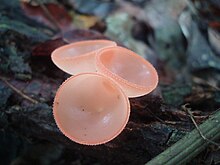|
Cookeina
 Cookeina is a genus of cup fungi in the family Sarcoscyphaceae, members of which may be found in tropical and subtropical regions of the world. Species may be found on fallen branches of angiosperms, trunks, and sometimes on fruits.[2] The Temuans of Peninsular Malaysia are reported to use certain species from this genus as food, and also as a bait for fishing, where it is rubbed against the hook.[3] DescriptionSpecies in the Cookeina have a deep, cup-shaped to funnel-shaped fruiting bodies, or apothecia. The inner spore-bearing surface of the apothecium, the hymenium, is brightly colored, yellow to red, although the color will fade upon drying. The outer surface is less brightly colored. The excipulum, the tissue making up the walls of the apothecium, is thin and flexible. When hairs are present on the apothecium, they are fasciculate—made of bundles of cylindrical hyphae.[4] Microscopic featuresThe Cookeina have asci which are constricted abruptly below and form a blunt, rounded base with a slim, tail-like connection. They have asci which mature simultaneously rather than in series.[5] They have paraphyses which anastomose and form a three-dimensional network. Ascospores are large (20—40 μm long), ellipsoidal or slightly unequal-sided, and either smooth or ornamented with fine wrinkles.[4] The genus appears to be restricted to wood, commonly to wood in early stages of decay.[4] Mechanism of spore releaseWhen mature apothecia become filled with water, the asci absorb some of that water and develop a Turgor pressure, a hydrostatic pressure within the ascus which put pressure on the tip of the ascus, held in place by the rigid ascus wall. As the water level in the cup reduces due to evaporation, the asci tips dry out, resulting in a negative vapor pressure that ultimately results in the thin tissue at the wall of the apex (the operculum) breaking outward, releasing the spores.[6] TaxonomyThe genus name of Cookeina is in honour of Mordecai Cubitt Cooke (1825–1914), who was an English botanist and mycologist.[7] The genus was circumscribed by Carl Ernst Otto Kuntz in Revis. Gen. Pl. Vol.2 on page 849 in 1891. PhylogenyPhylogenetic analyses of ribosomal DNA has helped to clarify the evolutionary and genetic relationships amongst the species in Cookeina. The species C. speciosa, C. tricholoma, and C. sinensis belong to a monophyletic group, and all are hairy, with stipes, and lack a well-defined layer of slime in the excipulum at maturity.[2] Another monophyletic grouping contains the species C. Venezuela and C. colensoi, which do have a slime layer on the excipulum, and have either short stipes or not at all (sessile).[2] In this analysis, C. indica and C. insititia did not clearly resolve with the other clades. The presence of some unique physical characteristics in the species C. insititia has made its taxonomic status uncertain, and a source of some debate in the literature— some authors have supported its segregation into the genus Boedijnopeziza,[8][9] and others have questioned this interpretation.[2][4][10][11][12] Based on a study of ultrastructural characteristics using electron microscopy, a possible solution to the taxonomic conundrum was suggested in 2003, to segregate C. insititia into a subgenus Boedijnopeziza within the Cookeina.[13] SpeciesCookeina colensoi (Berk.) Seaver (1913).[14][15] Cookeina colensoiopsis Iturr. & Pfister (2006).[18] Cookeina globosa Douanla-Meli (2005). This species is known only from the Mbalmayo rain forest reserve in southern Cameroon.[17] Cookeina indica Pfister & R. Kaushal (1984).[19] Cookeina insititia (Berk. & M.A. Curtis) Kuntze (1891).  Apothecia deeply cupulate, 3–6 mm in diameter when dry; ectal excipulum of texture subglobulosa to textura angularis, with a gelatinous layer about 40–85 μm thick in ectal excipulum; triangular scalelike hairs arising from ectal excipulum forming several rings along apothecial margin, less than 4 mm long; medullary excipulum of textura intricata, 45–100 μm thick; hymenium about 380–430 μm; asci 400–440 × 13–17 μm; ascospores fusoid, smooth, multiguttulate, 45–53.5 × 9–13 μm.[16] Distribution restricted to the western Pacific Basin.[4] Cookeina sinensis Z. Wang (1997).[16] Cookeina speciosa (Fr.) Dennis (1994).[20]  Apothecia funnel-shaped, stipitate, rarely sessile, margin covered with fine, inconspicuous hairs; hairs fasciculate, less than 3 mm long; asci 300–400 × 17–20 μm; ascospores ellipsoid, biguttulate, surface with fine longitudinal ridges, 25–29 × 13–15 μm.[16] Cookeina sulcipes (Berk.) Kuntze (1891).  Basionym Peziza sulcipes Berk. (1842). Cookeina tricholoma (Mont.) Kuntze (1891).  Apothecia are goblet to funnel-shaped with an inrolled margin, 1–2 cm (0.4–0.8 in) in diameter, with slender stipes that are 1–3 cm (0.4–1 in) tall, The apothecia are conspicuously hairy; hairs stiff, bristle-like, fasciculate, and usually 2–3 mm long. Its asci are 280–350 × 13–18 μm. The ascospores pointed-ellipsoid, surface with fine, longitudinal ridges, biguttulate, 25–35 × 11–13.5 μm. The typical habitat is on wood like twigs and rotten tree limbs, at low altitudes (usually below 1000 m), in the tropics. The distribution of this species includes the lowlands of Central America, Mexico, the Caribbean, South America, Africa, Asia, Australia, and the South Pacific.[4][16] Cookeina venezuelae (Berk. & Curt in Cooke) Le Gal (1953).[10] Similar generaThree other tropical genera of the family Sarcoscyphaceae, Phillipsia, Sarcoscypha, and Geodina, have brightly colored apothecia which might be confused with those of Cookeina. Although these genera may be distinguished microscopically because they all have asci which mature seriatim rather than simultaneously and paraphyses which do not anastomose to form a reticulum, distinguishing on the basis of macroscopic characters is less reliable. Species of Phyllipsia have apothecia that are saucer-shaped to discoid, thick-fleshed, and usually sessile. In Sarcoscypha the apothecia vary from saucer-shaped to cup-shaped and are usually stipitate. In Geodina the apothecia are cup-shaped, stipitate, and occur on soil. Another similar genus, Scutellinia, has eyelash-like hairs around the margin of a red or orange apothecia, but lacks a stipe. References
External links |
||||||||||||||||||||||||||||||||
